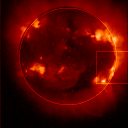


| JAVAScript movie (820 kbyte) | Animated GIF movie (804 kbyte) | MPEG movie (71 kbyte) |
The sudden brightening at 04:57 UT is the second flare. One can observe plasma flowing northward from the flare site, into the nearby structures just at the top edge of the field of view. Furthermore, the plasma impacting the northern structure appears to be deflected in two directions, as if the path of the ejection is "forked". The simplest explanation is that the plasma follows the magnetic field lines, and the different field lines leading out of the flaring region go in different directions.
The field of view of these images is quite large: 10.5 x 10.5 arcmin. The angular resolution is 9.8 arcseconds per pixel (i.e., seven thousand kilometers per pixel). Thus the path of the ejected plasma is some 140 thousand kilometers, and the inferred speeds are between 350-600 km/sec. This is not so extreme, but falls neatly into the range of speeds observed for ejecta from other flares (e.g., Shibata et al. 1995, ApJL, 451, L83). It is interesting that the ejected material in the present case is preferentially channeled along the magnetic field lines connecting to the structure in the north. This stands in distinct contrast to other examples of flare ejecta which have not been so narrowly focused; see for example the ejection movies of this previous nugget. Instead the present case is probably more similar to the "Jets in Giant Interconnecting Loops" described in the nugget for Week 7, 1999.